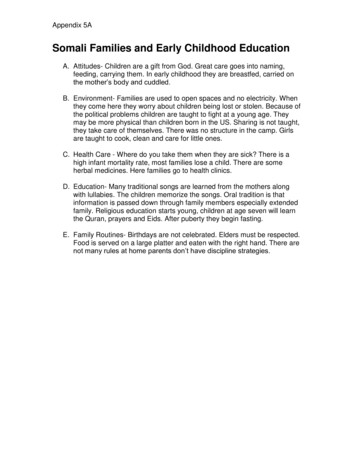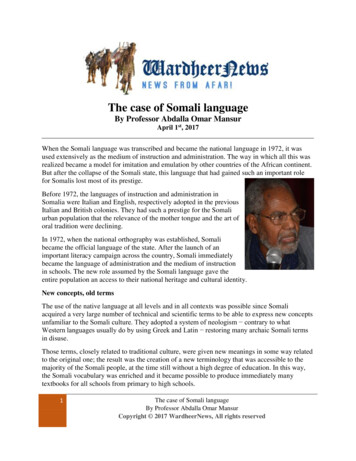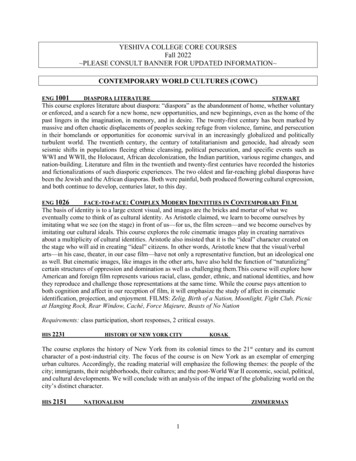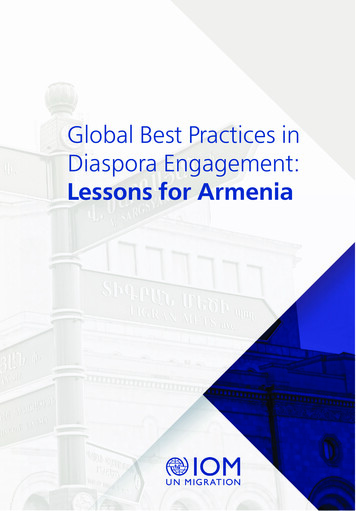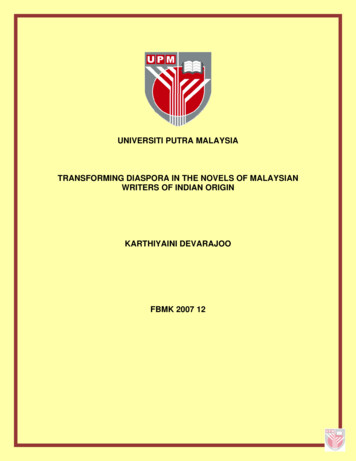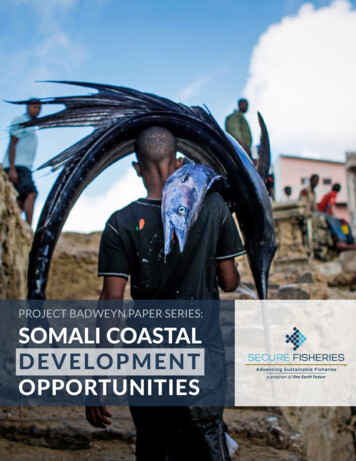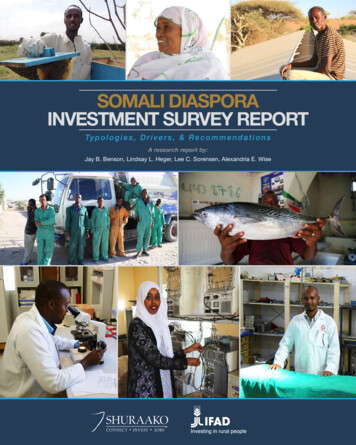
Transcription
SOMALI DIASPORAINVESTMENT SURVEY REPORTTy p o l o g i e s , D r i v e r s , & R e c o m m e n d a t i o n sA research report by:Jay B. Benson, Lindsay L. Heger, Lee C. Sorensen, Alexandria E. Wise
SOMALI DIASPORAINVESTMENT SURVEY REPORTTy p o l o g i e s , D r i v e r s , & R e c o m m e n d a t i o n sA research report by:Jay B. Benson, Lindsay L. Heger, Lee C. Sorensen, Alexandria E. WiseShuraako is a program of the One Earth Future Foundationw w w. o n e e a r t h f u t u r e . o r gCover Photos: Somali entrepreneursAll photos in this report, unless otherwise noted, are by Jean-Pierre Larroque, One Earth Future Foundation
Somali Diaspora Investment Survey 1TABLE OF CONTENTSACKNOWLEDGMENTS. 3EXECUTIVE SUMMARY. 6I. INTRODUCTION: BACKGROUND & RESEARCH GOALS. 8II. RESEARCH GOALS AND METHODOLOGY. 10a. Focus Groups.10b. Interviews With Key Actors.10c. Online Survey.11III. DIASPORAS IN PERSPECTIVE. 11a. Diaspora Contributions To Development.11b. The Somali Regions, Diaspora, And Development.13c. Investment Is Key.14IV. RESPONDENT POPULATION AT A GLANCE. 16a. Standard Demographics.16b. Connections To The Somali Regions.18c. Identifying The Somali Diaspora.19V. FINANCIAL ENGAGEMENT IN THE SOMALI REGIONS. 20a. Remittance Behavior In Focus.21b. Investment Behavior In Focus.22c. Remittances, Investments, And Somali Growth.23VI. DESCRIBING INVESTMENTS AND INVESTORS. 25a. Investment Size, Frequency, And Sectors.25b. Investment Origination.26c. Forms Of Investment.28VII. MOTIVATIONS FOR INVESTMENT INTO THE SOMALI REGIONS. 30a. Profit Potential.31b. Social Investment.32c. Returning Diaspora.33VIII. PERCEIVED OBSTACLES AND RISK MITIGATION STRATEGIES. 34a. Perceptions Of Risk And Risk Tolerance.34b. Obstacles To Somali Investments.35c. Overcoming Obstacles And Reducing Risk.36IX. RECOMMENDATIONS. 401. Strengthen the capacity of local actors to provide demand-drivenbusiness development services.412. Support the development of effective chambers of commerce andbusiness associations.423. Encourage formal data collection and commission relevant market researchin partnership with local chambers and ministries.454. Encourage information-sharing through diaspora investor networks and encouragediaspora investor “meet-ups” that are built around investors’ profiles.475. Partner with SFIs to champion “savings-to-investment” campaigns.496. Support credit products that leverage locked-up real estate value.517. Provide tangible assurances to diaspora investors.538. Develop mutual funds that offer varied risk profiles, target key sectors,and produce a double bottom line.55
2 Somali Diaspora Investment Survey9. Promote community development finance, including community infrastructure bondsand risk insurance.56ENDNOTES . 59APPENDIX A Survey Responses All Countries.IAPPENDIX B Survey Respondents Who Self-Identify Somali Region of Origin.IIAPPENDIX C Diaspora vs. Non-Diaspora Investment Opportunity Comparison.IIIAPPENDIX D Complete Detail of Figure 11. IVAPPENDIX E Complete Detail of Figure 23. VCOMPLETE LIST OF FIGURES1Focus Group Demographics Summary102Survey Responses by Country153Percentage of Respondents by Age154Religious Service Attendance175Occupation176Component Parts of the Wealth Index187Wealth Index of the 5 Countries with the Most Frequent Respondents188House Ownership189Percentage of People Owning a Home in Somalia1910Percentage of People Owning a Business in Somalia1911Remitter and Investor Profile Comparison2012Monthly Remittance Categories & Savings Accounts, Home Ownership2113How Remitters Believe Their Money is Spent2214Investor Representation by Country2315Most Common Sectors for Somali Investments2516Who Somalis Trust for Investment Recommendations2717Most Attractive Investment Options for Somali Investors2818Awareness of Co-Investment Opportunities2919Percent of Investment Type Preference by Various Factors2920Most Important Factors for Investing in Somali Businesses3021Factors Influencing Somali-Based Investment Decisions3022Probability of Somali Investments3123Most Attractive Fund Type to Somali Investors3124Investments Intended to Create Local Jobs3225Investor Motivation for Employment Generation, by Age3226Investments Motivated by Future Interest in Returning Home3327Financial Risk Tolerance3428Demographic Characteristics of Individuals3529Obstacles to Investment3630Preferred Strategies for Reducing Investment Risk3731Preferred Up-Front Assurance for Investments38
Somali Diaspora Investment Survey 3ACKNOWLEDGMENTSWe’d like to extend a special thank you to the following individuals who have helped us through conversation and contributionsto this report.Lars Benson, Center for International Private EnterpriseLars Benson is Senior Program Officer for Africa at the Center for International Private Enterprise (CIPE). He works withlocal partners on public policy advocacy, anti-corruption efforts, governance, and creating favorable business environmentsfor entrepreneurs. CIPE is affiliated with the US Chamber of Commerce and the National Endowment for Democracy. CIPEhas worked in more than 100 countries supporting private sector initiatives to develop market economies and strengthendemocratic development.David Bledsoe, LandesaDavid Bledsoe leads Landesa’s corporate engagement initiative, which supports clients in making socially responsibleinvestments in land and land-focused supply chains. He has supported businesses in this regard in Africa, Asia, and LatinAmerica. He has also served as Landesa’s Africa Program Director and has designed and managed programs funded by USAID,DFID, the World Bank, and many foundations. He has extensive experience working with corporations, governments, andcommunities on land policies and laws, land-related investments, women’s access and secure rights to land, land disputeidentification and resolution, and more.Nana Boakye-Adjei, Developing Markets AssociatesNana Boakye-Adjei is Associate Director at Developing Markets Associates (DMA). She has key expertise in private sectordevelopment, with a specific focus on remittances, payments systems, and financial inclusion. More recently she has ledDMA’s work with diaspora communities, specifically in relation to diaspora investment, designing programs for both donororganizations and the private sector.Leon Isaacs, Developing Markets AssociatesLeon Isaacs is recognized as a global authority in the remittances and money transfer industry and as a seasoned businessleader. He has been Managing Director of the International Association of Money Transfer Networks, an international tradeassociation. He has also spoken at, and chaired, numerous international conferences on remittances, including at the WorldBank, the UN, and the G8. Prior to establishing DMA, he was intrinsically involved with two successful start-up money transferbusinesses: MoneyGram International and Coinstar Money Transfer.Leigh Moran, Calvert FoundationLeigh Moran is Senior Officer on the strategy team at Calvert Foundation, an impact investing nonprofit that enables peopleto invest for social good. She focuses on the design and implementation of investment initiatives based on key social impactareas. Moran is currently leading Calvert Foundation’s work to engage diaspora communities to invest in the economicdevelopment of their countries of heritage.Liesl Riddle, George Washington UniversityLiesl Riddle is Associate Professor of International Business and International Affairs at George Washington Universityand Associate Dean for Graduate Programs at The George Washington University School of Business. Having examineddiaspora investment and entrepreneurship for more than 20 years, Dr. Riddle has conducted research among 16 differentdiaspora communities, and has also spearheaded the university’s Diaspora Capital Investment Project, and was aa foundingmember and director of their Diaspora Research Program.
4 Somali Diaspora Investment SurveyErin Satterlee, Forcier ConsultingErin Satterlee is Partner at Forcier Consulting, a multinational research and consulting firm. Mr. Satterlee founded ForcierConsulting, Somalia, and has led the firm’s local team comprised of 50 full-time staff, of which more than 40 are Somali,on more than 85 in-region projects and research initiatives. Prior to joining Forcier, Mr. Satterlee worked with the BelgianDevelopment Agency and led the creation of more than 300 micro-credit associations throughout western Uganda on behalfof the Bill & Melinda Gates Foundation. Mr. Satterlee is the ESOMAR Worldwide Market Research Representative for Somaliaand a member of the American Evaluation Association.Justin Sykes, Innovest AdvisoryJustin Sykes is Founder and Managing Director of Innovest Advisory, which is a boutique advisory service linking sociallyminded investors with impact investment opportunities.We’d also like to acknowledge and thank the following individuals from the Somali diaspora who helped organize the focusgroups and individual interviews:Said AbdirahmanAhmed AdanAbdirahman AliAbdirachid FidowWeli HassanKhader Ismail MohamedThe One Earth Future Foundation and Shuraako take no position on the division of Somali territories, nor advocate for any outcome in thedefinitions of territorial boundaries or citizenship. Our choice of wording in this document reflects an attempt to give equal voice to allpeople of the region. To the extent possible, regions will be referred to individually, to include “South Central Somalia,” “Somaliland,” and“Puntland” as well as all individual regions. Where we must be more inclusive, this report will refer to “the Somali region” as a whole or“Somali regions” to refer to the separate regions. This should not be construed to include any part of other countries in the region. Manyinternational organizations do not collect or analyze data that reflect the multifarious Somali political designations or preferences and thusdata will first refer to the above designations and secondarily to the unit of analysis included in the cited works which might include theterm “Somalia” etc. to refer to the entire region, as for example, when referring to population statistics provided by the United Nations.Theimages used in this document will similarly avoid contested designations of territory.
Somali Diaspora Investment Survey 5ORGANIZATIONSInternational Fund for Agricultural DevelopmentThe International Fund for Agricultural Development (IFAD) co-funded the Somali Diaspora Investment Survey (SDIS) alongwith Shuraako. IFAD is a specialized agency of the United Nations and an international financial institution. Its goal is to enablepoor rural people to improve their food and nutrition security, increase their incomes, and strengthen their resilience. IFAD’smultilateral orientation provides a strong global platform for discussing rural policy issues and increasing awareness of whyinvestment in agriculture and rural development is critical to reducing poverty and improving global food security. The SDISwas financed through the "Enhancing Food Security in the Horn of Africa through the Diaspora Investment in AgricultureProgramme" implemented in Somalia and financed by IFAD's Near East, North Africa and Europe (NEN) division. The projectis implemented under the framework of the Diaspora Investment in Agriculture (DIA) initiative launched in 2011 by IFADin collaboration with the U.S. Department of State. The DIA aims at leveraging the contributions of migrant workers andencourage their engagement in sustainable economic development through investment in agriculture, particularly in ruralareas. DIA is managed by IFAD's Financing Facility for Remittances (FFR), that has been working since 2006 with the goalof increasing the development impact of remittances and diaspora investments towards enabling poor rural households toadvance on the road to financial independence.Shuraako and the One Earth Future FoundationShuraako is a nonprofit implementation project of the One Earth Future Foundation (OEF). Shuraako brokers economicallybeneficial relationships that connect micro, small, and medium-sized enterprises (MSMEs) with investors to catalyzejob creation. This in turn contributes to a more resilient and peaceful Somalia. Shuraako achieves this by identifying andrecommending eligible Somali businesses to impact investors and charitable funds, and by servicing approved financing.Shuraako seeks to foster a thriving business sector by addressing the financial gap in Somalia and brokering productivepartnerships that encourage economic development.OEF is a nonprofit, nongovernmental organization that was founded in 2007. OEF is an operating foundation with a vision ofdeveloping effective multistakeholder systems of governance to achieve a world beyond war. Research & Development (alongwith Oceans Beyond Piracy, Secure Fisheries, and Shuraako) is a program of OEF.AUTHORSJay B. Benson—Researcher, One Earth Future FoundationLindsay L. Heger, PhD—Associate Director, Research & Development, One Earth Future FoundationLee C. Sorensen—Director, ShuraakoAlexandria E. Wise—Associate Director, ShuraakoCONTRIBUTORSAbdikarim Gole—Field Manager, ShuraakoMahad Awale—Field Manager, ShuraakoAndrea Jovanovic and Timothy Schommer—Layout & DesignJean-Pierre Larroque—Photography
6 Somali Diaspora Investment SurveyEXECUTIVE SUMMARYAs the Somali regions continue their emergence from decades of civil war and political contestation, investment is expanding,banks are opening their doors, and Somali exports are increasingly finding markets throughout the Middle East and EastAfrica. Those most anxious to embrace the growing Somali private sector, as well as expand Somali product exports to foreignmarkets, are the members of the Somali diaspora spread around the world. Through remittances and small investments, theseindividuals provide a critical lifeline for individuals in the Somali regions, as well as for businesses. As the political climatestabilizes, many diaspora members are contemplating how and when to make investments. In an effort to facilitate positivegrowth, the international community is seeking insight into the Somali investment climate, investor interests, and potentialmechanisms for encouraging diaspora investment.Given the overall lack of data offering guidance on the subject, the International Fund for Agricultural Development (IFAD)commissioned Shuraako (a project of the One Earth Future Foundation) to conduct the Somali Diaspora Investment Survey(SDIS). The SDIS gathered information about the preferences and behaviors of Somalis and the Somali diaspora toward existingchannels and opportunities for Somali-based investments. Hundreds of Somali diaspora and current residents were queriedabout their opinions, observations, and habits regarding remittances and investment in the Somali regions.This report summarizes these findings in eight major sections:1. Research Goals and MethodologyEleven focus groups with members of the Somali diaspora were conducted in eight cities on three continents. Thesefocus group discussions aided a better understanding of the nature of diaspora remittances and investments in theSomali regions. These discussions were supplemented by in-depth interviews. Finally, an online survey identifiedcurrent trends in remittance and investment behaviors, as well as the motivations for investment and the obstaclesto increased financial engagement in the Somali regions.2. Diasporas In PerspectiveDiaspora communities around the globe contribute to the socioeconomic development of their home countriesthrough remittances, investment, human capital transfer, trade facilitation, and philanthropy. While the Somalidiaspora has played a role in mitigating the worst of the humanitarian disasters through remittances, this is ashort-term solution. Increased diaspora investment will be necessary if their financial transfers are to be effectivelyleveraged for sustainable, long-term economic development in the Somali regions.3. Research Participant ProfileAmong the 923 survey participants, respondents ranged in age from 16 to 77 and represented 33 countries, withoccupations falling into 17 different sectors from education to transportation.4. Financial Engagement in the Somali RegionsThe financial engagement of the Somali diaspora in their country of origin primarily takes two forms, remittancesand investments.a.Remitters: Individuals who send remittances are, on average, slightly wealthier than the non-remitterpopulation. Remitters who took the survey sent an average of US 422.90 per month to family and friendsin the Somali regions. Senders indicated that these funds were used overwhelmingly for basic, reoccurringneeds such as food, education, and health care.b.Investors: Nearly 60% of respondents reported being active investors and 33% have recently invested in theSomali regions. Active investors responded from 12 countries across Africa, Europe, and North America, thehighest concentration of which (78%) came from only four main areas: the Somali regions, the UK, Canada,and the US (in descending order).
Somali Diaspora Investment Survey 75. Describing Investments and InvestorsFocus group participants and online survey respondents openly shared their experiences with Somali investments:a.Size: Typical diaspora-funded investments are between US 5,000 and US 100,000, with the majority beingbetween US 5,000 and US 50,000.b.Frequency: Frequency is based on available opportunities. Nearly 1/3 of respondents indicated having madeinvestments in the Somali regions in the past three years.c.Sector Distribution: Investments are distributed across 22 sectors, with the greatest concentration inagriculture, real estate, and education (in descending order).d.Origination: Diaspora members are most likely to trust business partners and local family members tooriginate and recommend investment opportunities. Friends and international institutions came in as thethird and fourth most important sources of investment opportunities, but their influence on origination wasless than half the level of the first two. The diaspora community, local chambers of commerce, and otheragencies play a significantly smaller role in investment origination.e.Forms of Investment: Many expressed a preference for direct investment into a single business, althoughthis is more significant among active investors. In comparison, those who did not identify as active investorswere more likely than those who did to prefer co-investments with other diaspora members and mutualfunds as forms of investment, due to their greater risk aversion or relatively weaker wealth position.6. Motivations for Diaspora InvestmentWhile multiple motivations were found to influence investment decisions, certain trends exist. Three in particularre-emerged throughout the survey: financial return, social good, and the potential for a future return to the Somaliregions. The most consistent across all criteria was the motivation to protect and grow capital, though sizeablenumbers of respondents also noted social good as being a motivating influence. To ensure capital protection andgrowth, investors seek three primary assurances: well-developed business plans, profitability, and high growthpotential. When asked, 85% of respondents claimed they placed capital with the goal (both express and in addition toprofitability) to create jobs. They also indicated placing investments that pursue future financial security or housingfor their own potential return to the Somali regions.7. Investment Obstacle Risk Mitigation Strategiesa.Risk Aversion: 46% of respondents identified themselves as having a “moderate” level of risk tolerance,34% described their risk tolerance as “low” or “very low,” and only 19% identified as “risk tolerant” or “riskacceptant.” Active investors were moderately more likely to describe themselves as more risk tolerant thanthe total respondent population.b.Obstacles to Investment: The top five most frequently cited obstacles to investing are political instability,security concerns, lack of rule of law, corruption, and an inadequate banking system. The top five obstaclesare less about the actual number or quality of investment opportunities or logistics than the systemicinstitutional obstacles reflecting the current state of governance in the region.8. RecommendationsThe final section of this report outlines nine recommendations based on analysis of the SDIS data. Eachrecommendation includes analytical justifications and actionable suggestions, and targets between one and fivedistinct actors based on where the data indicate unitary action or multi-stakeholder cooperation is best suited. Therecommendations target the Somali business community (including chambers of commerce, business associations,and the private sector); Somali financial institutions (SFIs); diaspora members; the global community (includinggovernments, multilateral organizations, development actors, and NGOs); and international financial institutions.Suggested courses of action seek to develop financial and business infrastructure, improve the quality of Somalimarket information, connect diaspora investors around the world, develop diaspora-specific investment products,and leverage locked-up real estate value through hybrid mortgage products.
8 Somali Diaspora Investment SurveyI.INTRODUCTION: BACKGROUND & RESEARCH GOALSAs the Somali regions continue their nearly quarter-century-long struggle for recovery from political collapse in the early 1990s,catalyzing investment to enable economic growth is a goal shared by stakeholders both inside and outside the area. Investmentin local communities can spur entrepreneurship, job creation, and the development of much-needed infrastructure. Theresulting increase in individual savings and development of capital could generate positive incentives to formalize the bankingsector and attract additional international capital. Moreover, economic development goes hand-in-hand with a lower risk ofterrorism and civil conflict. Undoubtedly, economic development is a first-order priority for the governments, multilateralorganizations, and nonprofits that seek ways to assist the Somali regions in their ongoing recovery.Investment is a key component in any business ecosystem, which is especially true in an ecosystem like the one in the Somaliregions, dominated by micro-sized enterprises in need of capital to grow and achieve economies of scale. An increasingnumber of foreign governments, companies, and investors are watching the Somali regions for private-sector development,scaled business growth, and investment opportunities. While there are a number of potential investors, the Somali diasporaremains the most committed and involved of these actors. These communities actively remit to family and friends, and havebeen a lifeline for many in the Somali regions. The World Bank estimates that US 1.3 billion1 flowed into Somalia from theworldwide diaspora in 2014, equal to 24% of GDP. In addition to remittances, which are largely spent on monthly householdexpenses, diaspora funds contribute significantly to private sector investment. Given their resources and close ties to familyand friends, diaspora members often provide capitalfor micro-startups. Many other diaspora seekpathways home; a healthy investment climate andstable economic outlook would provide assurancesfor those wishing to return.Small business owner in HargeisaThese important flows of diaspora funds to theSomali economy continue despite many challenges.The security, economic, and political problemsof the Somali regions have taken a heavy tollon the effectiveness of regulatory institutions.As a consequence, money transfer channels arelargely informal, and thus subject to associatedproblems such as corruption, the potential financingof terrorism, and money laundering. Somalis,both diaspora and non-diaspora, along with theinternational community, require transparent andreliable investment channels capable of overcomingthese problems and reaching growing businesses inneed of capital.To gain insight into the elements required to develop Somali-based investment mechanisms, the International Fund forAgricultural Development (IFAD), through its Financial Facility for Remittances, commissioned Shuraako (a project of theOne Earth Future Foundation) to conduct the Somali Diaspora Investment Survey (SDIS). The SDIS collected data betweenMarch and August 2015 using three methodologies: focus groups conducted around the world, in-depth interviews with keySomali diaspora members, and an online survey with over 900 respondents. All methods gathered information about thepreferences and behaviors of Somalis and the Somali diaspora toward existing investment channels and opportunities in theSomali regions. Specifically, the SDIS and this report provide insight into the following: The role diasporas across the globe play in the development of their countries of origin. The report exploresthe roles of remittances, investment, human capital, trade facilitation, and philanthropy. It also discussesthe need to transition from reliance on remittances to increased private sector investment for long-termdevelopment in the Somali context.
Somali Diaspora Investment Survey 9 Basic demographics of the survey population. This provides insights into the comparative wealth, sectors ofemployment, intensity of ties to the Somali regions, and other characteristics of the Somali diaspora across33 countries. Investor and remittance-sender profiles. The profiles include demographic characteristics (including thoseof active diaspora investors), investment preferences, and remittance behavior, as well as characteristicsof those who would like to invest but have not done so yet, and include the reasons or modalities that maysupport or deter their investing. A typology description of preferred channels for investment. The typology includes channels such as familyand friends, business partners, and international institutions used for identifying attractive investmentopportunities. The description addresses how diaspora investors identify investment opportunities in theSomali regions and how best to expand such options while at the same time ensuring the level of trust andsecuri
Liesl Riddle is Associate Professor of International Business and International Affairs at George Washington University and Associate Dean for Graduate Programs at The George Washington University School of Business. Having examined diaspora investment and entrepreneurship for more than 20 years, Dr. Riddle has conducted research among 16 different

